Silicon Valley Bank collapsed last week—a not exactly surprising event as interest rates rise after years of easy credit. But out of the thousands of banks in America, why did SVB go under? Florida Gov. Ron DeSantis shared his own theory during an interview with Fox News’ Maria Bartiromo: “This bank, they’re so concerned with DEI and politics and all kinds of stuff. I think that really diverted from them focusing on their core mission.”
Did wokeness kill America’s 16th largest bank?
First, it’s important to understand what’s being discussed. DEI—diversity, equity, and inclusion—programs have become widespread in the world of business and education. Such programs incorporate initiatives like unconscious-bias training while emphasizing diverse hiring practices and more inclusive language. ESG—which stands for “environmental, social, and governance,” referring to objectives of stakeholder capitalism—also has been a big part of Republican rhetoric going into the 2024 election. In Republican circles both terms, along with woke and wokeness, have become shorthand for political progressive overreach.
DeSantis isn’t alone in suggesting DEI, ESG, or just general wokeness played a role in SVB’s downfall. GOP Rep. James Comer, chairman of the House Oversight Committee, called SVB “one of the most woke banks in their quest for the ESG-type policy and investing.” Donald Trump Jr. tweeted, “SVB is what happens when you push a leftist/woke ideology and have that take precedent [sic] over common sense business practices.” Right wing activist Charlie Kirk, Sen. Mike Lee, and Rep. Andy Biggs also jumped on the SVB woke train.
Indeed, SVB featured its DEI program prominently online—with a percentage breakdown of the race and gender makeup of its workforce, senior leadership, and board. The bank’s 2022 ESG Report set goals like having 43 percent of senior leadership positions in the company internationally filled by women by 2025; increasing the number of black-held senior leadership positions from 4 percent to 5 percent in the United States; and increasing the amount of money spent on “diverse suppliers” to 8 percent. SVB also committed to having its entire workforce participate in DEI training by 2023.
There is no doubt that SVB prioritized DEI and ESG principles, but did that lead to the bank’s collapse?
Robert Shimer, the chair of economics at the University of Chicago, is an expert in this and says he isn’t convinced.
“I haven't seen evidence that SVB was more focused on DEI than its peers who did not fail, leaving me skeptical of this explanation. There was obviously a huge failure of risk management, but I'm not sure an excess focus on DEI explains that.”
Gregory Brown, a professor of finance at UNC–Chapel Hill and executive director of the Frank Hawkins Kenan Institute of Private Enterprise, concurred, saying the issue wasn’t DEI but investment in long-term assets preventing meeting immediate demand for cash.
“If you had to identify a key failing,” said Brown, “it was not managing the interest rate risk. This is a pretty straightforward task (e.g., easy to do with interest rate swaps, etc), so it seems like there was some failure of governance around risk management.”
Steve Moore is a fellow at the Heritage Foundation and former economic adviser to President Donald Trump. He believes the collapse is “a good wake up call for corporate America,” even if there’s not a perfect line connecting wokeness to financial ruin.
“I'm not an expert on this,” Moore said. “My general view is that the bank board's weird obsession with ESG diverted their full attention to their primary goal of making money for the shareholders and avoiding systemic risks.”
SVB had invested heavily in long-maturity U.S. Treasury bonds and mortgage-backed securities, and the value of both dropped as the Federal Reserve hiked interest rates repeatedly. At the end of 2022, SVB was looking at an unrealized loss of $15.1 billion. Bonds pay out at the end of a set term, and while SVB initially planned on holding on to the bonds until they reached maturity, a cash shortfall forced SVB to start selling assets. The bank sold off a $21 billion portfolio that consisted mostly of bonds, losing $1.8 billion in the process. The resulting announcement of a share sale to make up for the loss and a drop in stock, prompted a run on the bank, and SVB did not have enough money to cover withdrawals.
Silicon Valley Bank was the 16th largest bank in the country at the end of 2022 in terms of assets. (Disclaimer: The Dispatch was a Silicon Valley Bank customer.)
Every bank larger than it has incorporated DEI into its business model and established a chief diversity officer or similar position or council. (JP Morgan Chase, Bank of America, Citi, Wells Fargo, US Bank, PNC Bank, Truist, Goldman Sachs, Capital One, TD Bank, Bank of New York Mellon, State Street, Citizens Bank, First Republic Bank, and Morgan Stanley.)
One thing that did differentiate SVB from other major banks? Its investments as a percentage of total assets. The average U.S. bank has 24 percent of its assets in investments. SVB had 57 percent. That meant a serious lack of liquidity, and its selloff of bonds to increase cash on hand cost it $1.8 billion.
“This would be related to a lack of G, not excessive G,” said Brown. “So maybe they needed more ESG not less! Guessing DeSantis is not really trying to do a nuanced analysis of the problems at SVB or ESG, just stirring the pot on this one.”







Please note that we at The Dispatch hold ourselves, our work, and our commenters to a higher standard than other places on the internet. We welcome comments that foster genuine debate or discussion—including comments critical of us or our work—but responses that include ad hominem attacks on fellow Dispatch members or are intended to stoke fear and anger may be moderated.
With your membership, you only have the ability to comment on The Morning Dispatch articles. Consider upgrading to join the conversation everywhere.